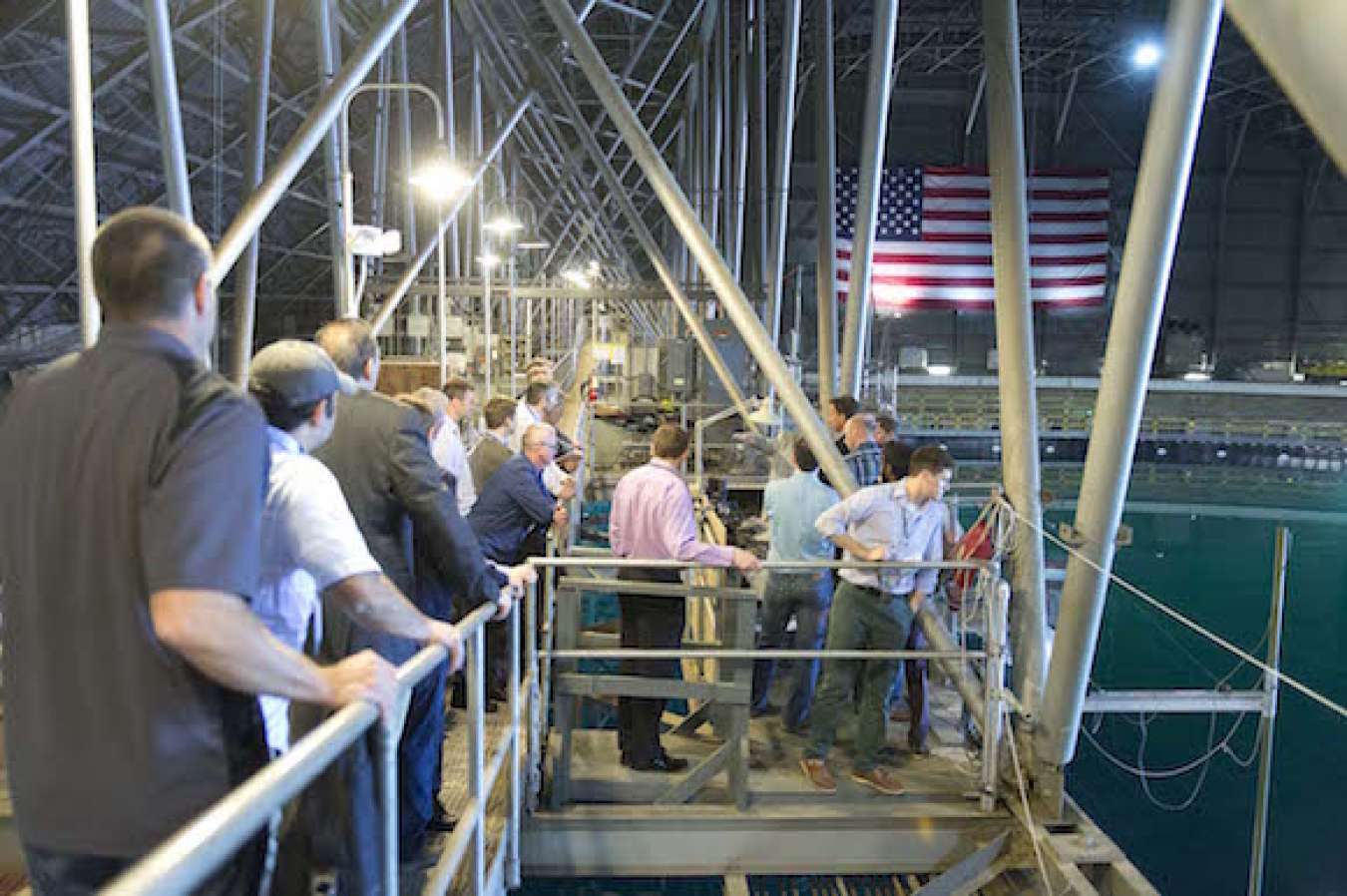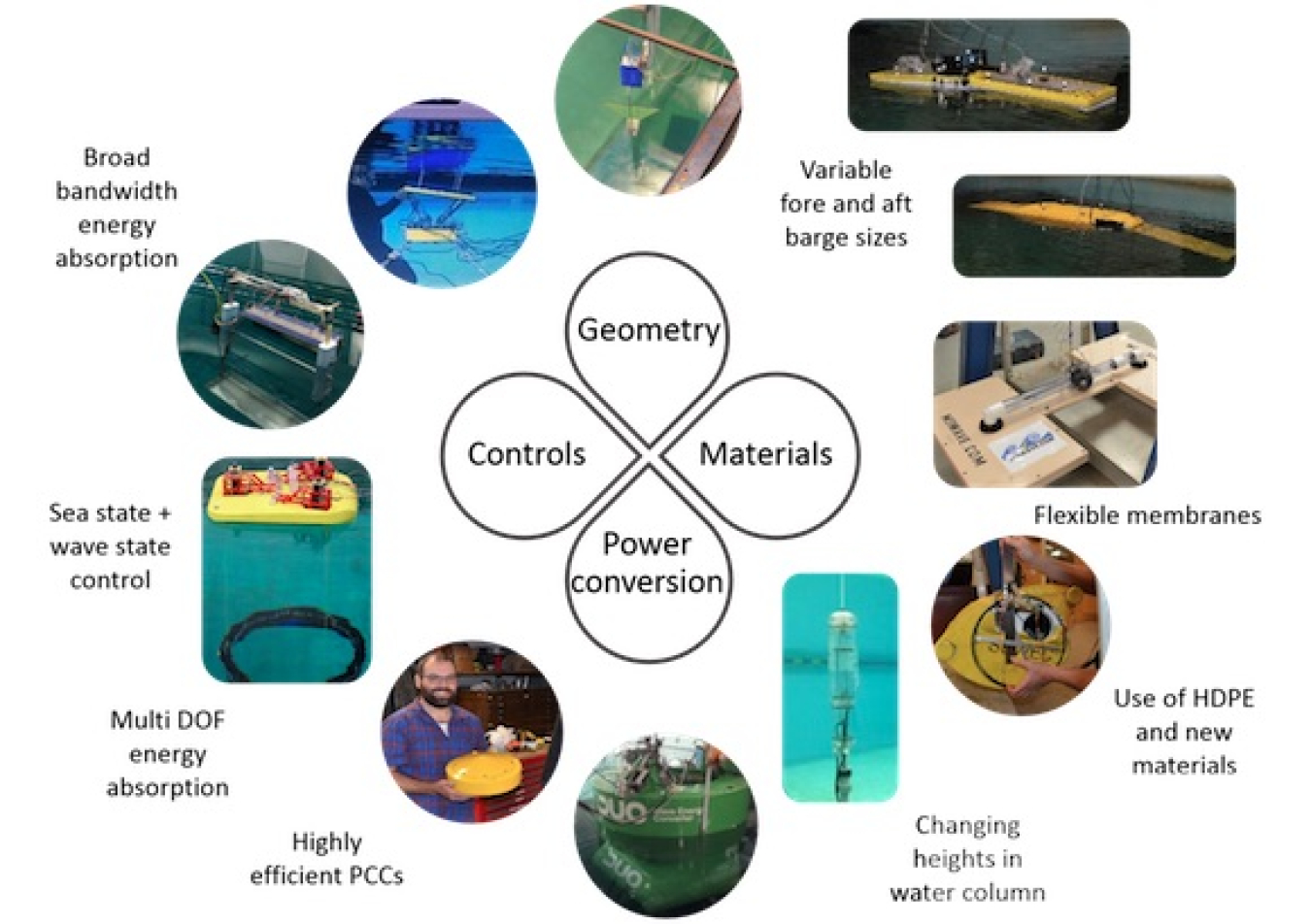Wave Energy Prize Program Update: A Look Back at Our First Year, a Look Ahead at Achieving Our Goals; Featured Press Coverage; Question of the Month.
Water Power Technologies Office
June 15, 2016Table of Contents
- Wave Energy Prize Program Update: A Look Back at Our First Year, a Look Ahead at Achieving Our Goals
- Featured Press Coverage
- Question of the Month

Wave Energy Prize Finalist Teams and Alternates tour the Maneuvering and Seakeeping (MASK) Basin at Carderock, Md. as part of the Team Summit, held April 27 during Waterpower Week. The teams were briefed by MASK personnel about logistics and technical requirements, then were able to tour the wave-generating facility where their 1/20th-scale wave energy converter prototypes will be tested beginning in August.
Wave Energy Prize Program Update: A Look Back at Our First Year, a Look Ahead at Achieving Our Goals
By Alison LaBonte, Ph.D.
Program Manager, Marine and Hydrokinetic Technologies, Wind and Water Technologies Office, U.S. Department of Energy

In 2012, the U.S. Department of Energy (DOE) realized that revolutionary advancements in wave energy were needed for it to play a significant role in our clean energy portfolio, making wave energy a great candidate for a public prize competition. The Wave Energy Prize is not your average research and development program: compressed timelines spark rapid innovation, resulting in revolutionary technology development.
Before we opened registration for the Wave Energy Prize, our team set an aggressive goal to double the state-of-the-art energy captured per unit structural cost of wave energy converters (WECs). With this goal came a number of program objectives, which are to:
- mobilize new and existing talent,
- conduct a rigorous comparison between device types,
- advance the understanding of pathways to achieve long-term levelized cost of energy goals, and
- attract investors and create a strong foundation for future funding opportunities
So far, we're achieving these ambitious objectives. A year ago, 92 teams registered for the Prize, three times more than we expected. Of these, 66 turned in technical submissions, which were evaluated by our panel of expert judges to identify 20 Qualified Teams. Most teams that registered were not previously known to DOE. Seventeen of the 20 Qualified Teams' completed the initial small scale testing phase, and only two of the nine teams selected for the final phase of testing have received any funding from DOE in the past.
In April, I updated the MHK community gathered at Waterpower Week in Washington, D.C., on the progress of the Prize during a panel discussion on innovation. So far, most of the teams have met the aggressive timelines for the Prize, which puts DOE in a great position to achieve the remaining objectives. To meet the requirements for Technology Gate 2, the Qualified Teams built 1/50th-scale model devices, tested them at university facilities around the country, and conducted significant numerical modeling studies in just four months.
The nine Finalist and two Alternate Teams have put forward diverse WEC designs, which include two submerged areal absorbers; four point absorbers; two attenuators; and three terminators. And in these designs, we're already seeing technical innovations in the areas of geometry, materials, power conversion and controls. Some of these include:
- adaptive sea state-to-sea state control,
- wave-to-wave control,
- power absorption in multiple degrees of freedom,
- optimized float shapes and dimensions for energy absorption for broad bandwidth of wave frequencies,
- survival strategies such as submerging beneath the surface for extreme storms,
- use of structures and materials that are cost effective to manufacture, and
- flexible membranes that react to the wave pressure over a broad area.
Waterpower Week attendees saw some of these innovations firsthand when they met the Finalists and Alternate Teams during the Wave Energy Prize Showcase in which the 1/50th-scale models were on display.
Industry stakeholders are taking notice, and the public's awareness of wave energy is increasing because of the teams' efforts in the Prize. In just over a year, more than 100 news stories have featured the Prize, including in outlets like Popular Science, The Weather Channel and National Geographic. The Prize's website has hosted more than 23,000 visitors, and its social media channels have logged more than a half million impressions. This increased awareness of the potential contribution of wave energy to the nation's renewable energy mix will exist long after the Prize ends, and will likely set the stage for future private-sector investments and government funding opportunities.
It's an exciting time to be in the wave energy community. The teams are putting the finishing touches on their 1/20th-scale prototypes, which will be rigorously tested at the U.S. Navy's MASK Basin from August through early October. Follow our teams' progress at waveenergyprize.org, and save the date for November 16, when winner(s), if any, will be announced!
Featured Press Clip
Making waves: DOE reboots marine hydrokinetic energy program to push commercialization
Utility Dive, Wed 13 May 2016
Question of the Month
Q: What are the requirements for Technology Gate 3?
A: Technology Gate 3 will verify the level of build progress and test readiness of the identified Finalist Teams and Alternates, and will determine the Finalist Teams that will participate in the 1/20th scale testing at the MASK Basin starting in August. By June 15, all Finalist Teams and Alternates must submit:
- video and photo documentation showing build progress of the device;
- video and photo documentation showing the critical dimensions for the device; and
- a plan showing the status of the team within their build process, the tasks remaining before the build is complete and the device is shipped to the MASK Basin, and any updates to the Model Design and Construction Plan, previously submitted on January 29.
Identified Finalists making it through Technology Gate 3 will be announced and posted on the Wave Energy Prize website no later than July 1.

